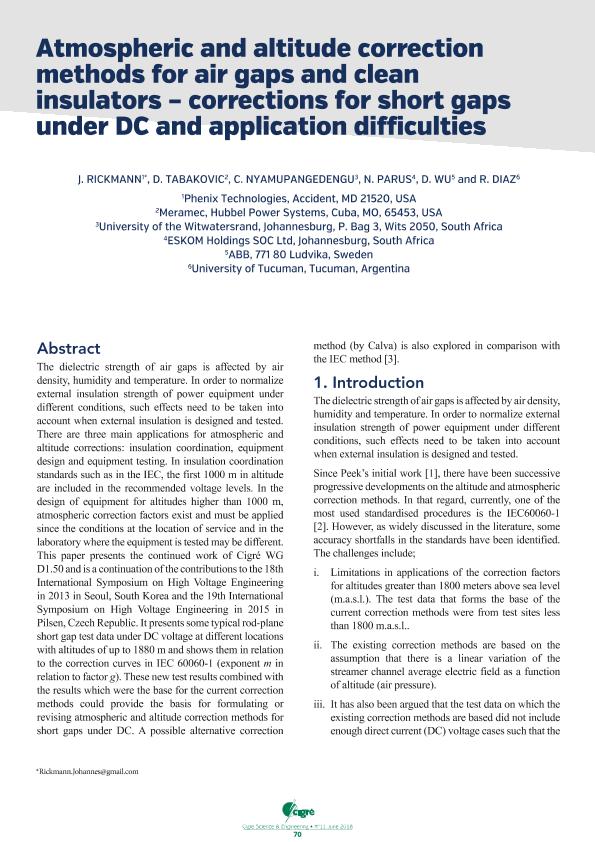Mostrar el registro sencillo del ítem
dc.contributor.author
Rickmann, J.
dc.contributor.author
Tabakovic, D.
dc.contributor.author
Wu, D.
dc.contributor.author
Nyamupangedengu, C.
dc.contributor.author
Diaz, Ricardo Ruben

dc.date.available
2019-08-15T19:41:53Z
dc.date.issued
2018-02
dc.identifier.citation
Rickmann, J.; Tabakovic, D.; Wu, D.; Nyamupangedengu, C.; Diaz, Ricardo Ruben; Atmospheric and altitude correction methods for air gaps and clean insulators-corrections for short gaps under DC and application difficulties; CIGRE; Cigre Science and Engineering; 11; 2-2018; 70-79
dc.identifier.issn
1286-1146
dc.identifier.uri
http://hdl.handle.net/11336/81675
dc.description.abstract
The dielectric strength of air gaps is affected by air density, humidity and temperature. In order to normalize external insulation strength of power equipment under different conditions, such effects need to be taken into account when external insulation is designed and tested. There are three main applications for atmospheric and altitude corrections: insulation coordination, equipment design and equipment testing. In insulation coordination standards such as in the IEC, the first 1000 m in altitude are included in the recommended voltage levels. In the design of equipment for altitudes higher than 1000 m, atmospheric correction factors exist and must be applied since the conditions at the location of service and in the laboratory where the equipment is tested may be different. This paper presents the continued work of Cigré WG D1.50 and is a continuation of the contributions to the 18th International Symposium on High Voltage Engineering in 2013 in Seoul, South Korea and the 19th International Symposium on High Voltage Engineering in 2015 in Pilsen, Czech Republic. It presents some typical rod-plane short gap test data under DC voltage at different locations with altitudes of up to 1880 m and shows them in relation to the correction curves in IEC 60060-1 (exponent m in relation to factor g). These new test results combined with the results which were the base for the current correction methods could provide the basis for formulating or revising atmospheric and altitude correction methods for short gaps under DC. A possible alternative correction method (by Calva) is also explored in comparison with the IEC method.
dc.format
application/pdf
dc.language.iso
eng
dc.publisher
CIGRE
dc.rights
info:eu-repo/semantics/openAccess
dc.rights.uri
https://creativecommons.org/licenses/by-nc-sa/2.5/ar/
dc.subject
Electrical Discharge
dc.subject
Atmospheric Correction
dc.subject
Air Gaps
dc.subject
Direct Current
dc.subject.classification
Ingeniería Eléctrica y Electrónica

dc.subject.classification
Ingeniería Eléctrica, Ingeniería Electrónica e Ingeniería de la Información

dc.subject.classification
INGENIERÍAS Y TECNOLOGÍAS

dc.title
Atmospheric and altitude correction methods for air gaps and clean insulators-corrections for short gaps under DC and application difficulties
dc.type
info:eu-repo/semantics/article
dc.type
info:ar-repo/semantics/artículo
dc.type
info:eu-repo/semantics/publishedVersion
dc.date.updated
2019-08-14T20:13:32Z
dc.journal.volume
11
dc.journal.pagination
70-79
dc.journal.pais
Francia

dc.journal.ciudad
Paris
dc.description.fil
Fil: Rickmann, J.. No especifíca;
dc.description.fil
Fil: Tabakovic, D.. No especifíca;
dc.description.fil
Fil: Wu, D.. No especifíca;
dc.description.fil
Fil: Nyamupangedengu, C.. University of the Witwatersrand; Sudáfrica
dc.description.fil
Fil: Diaz, Ricardo Ruben. Universidad Nacional de Tucumán; Argentina. Consejo Nacional de Investigaciones Científicas y Técnicas. Centro Científico Tecnológico Conicet - Tucumán; Argentina
dc.journal.title
Cigre Science and Engineering
dc.relation.alternativeid
info:eu-repo/semantics/altIdentifier/url/https://e-cigre.org/publication/CSE011-cse-011
Archivos asociados
